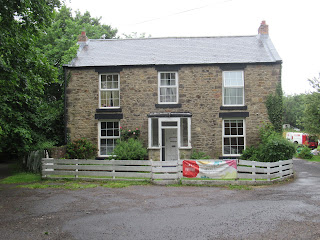Hadrians Wall, Newcastle, Segedunum
The visitor entre as Segudunum, the last fort on Hadrian's Wall in Wallsend in Newcastle.
The visitor centre viewed from the excavated ruins of the Roman fort. The museum opening hours are 10am to 3pm so unless I was going to loss half a day of walking, I would not see the runs themselves but I had visited before so I didn't feel that I was losing out.
There is not much to see through the fence surrounding the site and only stones poking out of the grass and hence the tall visitors tower to give a better view of the site. There was also a sign on one onf the entrances saying that the museum was shut due to 'enexpected developments'...it was during teh COVID breakout but no specific reason was given.
A stylised Roman centurion acting as security based on a theme from the Angel of the North in rusting metal.
Just to the south of teh fort are the repaired Roman Baths.
Along this first section of the wall are several 'benches' made out of sections of re-purposed riveted H beam metal girders but unless you are desparate, the rivets on the top make sitting uncomfortable.
Despite being in a busy city this section is lined with greenery and trees and you might not guess that you are walking through a major conurbation. This is just a glimpse through the trees at a marina on the River Tyne far below.

A metal sculpture of a dinosaur above the trail.
The trail goes down the steep cliffs facing the Tyne and follows it along the bank through Quayside passing several iconic sights of teh city such as the Millenium Bridge...
...the Baltic Flour Mill....

...and opposite both, a boutique hotel called teh Malmaison, the same name as Napoleon's home, On my previous visit to Newcastle, I had stayed in left hand suite of the two suites at the top of the hotel, each one having one of the odd shaped windows just beneath the company name.
The iconic low level swing bridge across the river with several other bridges in the background,
An arm of the swing bridge in the foreground and behind is a double decker bridge with a railway on top and teh lower level carries a road.
All along the quayside are things of interest, such as this hanging basket display...
...and various information boards such as this one to Lord Armstrong, a local engineer, industrialist and philanthropist who founded Armstrong Whitworth, noted for their artillery developments and builder of Cragside, the first residence to be lit by hydroelectricity and a fascinating lace to visit.
After walking along the quayside and through the Tyne Riverside Country Park, the trail makes a steep and long ascent up the side of the valley. This is a view from the top across the Tyne which is out of sight in the depths of the valley.
On op of the grave stone is a granite pebble with a poppy painted on it.
At last, just 60 metres off the course of the signed trail, late in the afternoon, my first real stretch of Hadrian's Wall, the base of a thick wall with dressed stone out facings disappearing down the slope of the hill.
I walked on to a fort on the route, Vindobala.
It was marked on the map but it was just bumpy field with nothing to see... except...
...an informative information board to enlighten the walker that hadn't read his guide book. Someone had spent time and effort in erecting these all along the route to inform passers by, whether they are locals out for a stroll out for a stroll or determined long distance path trekkers.
It was time to get home but there is little accommodation on the route and any day walk often includes some distance to walk away from the Hadrian's Wall. It was a three mile walk on top of the day's walk along the trail to get to Wylam, the nearest railway station.
I had checked out buses but the times were all wrong, the first and last buses at odd times and for rural areas, some only ran on certain days so unless you had time and money in order to have a few days off to match the timetables, the train was a better option for me. Hence I waked down teh slope to Wylam.

A sign in the village centre.
It took a bit of searching as other than that single sign, there were no others but I found George Stephenson's cottage in a secluded position not far from the banks of the Tyne North River. Not sign posted but now a bed and breakfast place was Timothy Hackworth's residence, a contemporary and friend of George Stephenson who lived locally who was also an engineer becoming the first locomotive superintendent of the Stockton and Darlington Railway and later designed the Wylam Class of locomotives.




















No comments:
Post a Comment